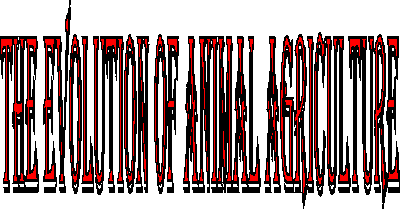
Gordon King, Department of Animal and Poultry Science, University of Guelph

"Edible, adj. good to eat and wholesome to digest, as a worm to a toad, a toad to a snake, a snake to a pig, a pig to a man and a man to a worm." [Bierce, A. The Devils Dictionary.]
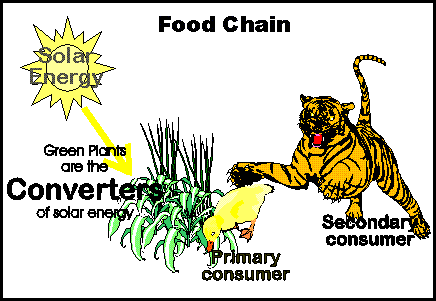 Every living organism is part of a food
chain so humans share a necessity to compete directly for nutrients with all
other species that are present in the ecosystem. Plants obtain all their
essential requirements for maintenance and function by using solar energy to
transform simple chemical elements into complex molecules. Animals cannot
convert solar energy so must obtain essential nutrients from other sources.
Every living organism is part of a food
chain so humans share a necessity to compete directly for nutrients with all
other species that are present in the ecosystem. Plants obtain all their
essential requirements for maintenance and function by using solar energy to
transform simple chemical elements into complex molecules. Animals cannot
convert solar energy so must obtain essential nutrients from other sources.
These initial farming efforts, although primitive by current standards, freed humans from total dependence on following wild game and allowed establishment of permanent settlements. Once more effective farming practices evolved, some individuals could pursue other activities for at least part of their time. Such alternative occupations eventually fostered the gradual transition from primitive to more civilized societies. The history of Homo sapiens as food producers rather than as food procure is relatively recent. Once established, however, agriculture reduced the danger of transient or prolonged food shortages and allowed time for other activities. Animal-Human interactions progressed through a series of antagonistic to commensal to exploitative stages.

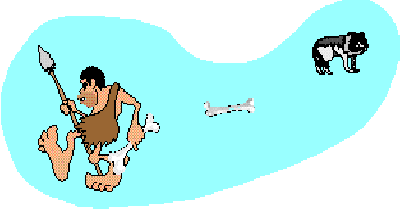
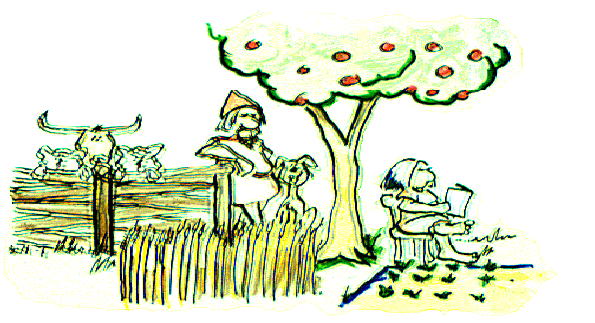 Sometime later, actual keeping of livestock specifically as a
food source began in tropical or semitropical regions of the Middle East.
The early farmers also discovered that whenever water was available, crops
could be produced during most of the year. Thereafter, domesticated animals
became an invaluable resource with smaller ruminants, pigs and poultry kept for
food production and large ruminants providing the power to operate irrigation
systems, plows and other farm implements. Additional innovations from antiquity
were exploitation of the milk let down reflex and selection of individuals for
prolonged lactation, allowing development of dairying. Also, the discovery of
methods for incubating birds' eggs without nesting hens led to increased
availability of poultry products. The Romans recognized and adopted improved
farming methods such as irrigation systems and oxen drawn plows encountered in
conquered regions. These techniques were subsequently introduced throughout
western Europe, along with the Roman-devised crop rotation and fallow systems.
Sometime later, actual keeping of livestock specifically as a
food source began in tropical or semitropical regions of the Middle East.
The early farmers also discovered that whenever water was available, crops
could be produced during most of the year. Thereafter, domesticated animals
became an invaluable resource with smaller ruminants, pigs and poultry kept for
food production and large ruminants providing the power to operate irrigation
systems, plows and other farm implements. Additional innovations from antiquity
were exploitation of the milk let down reflex and selection of individuals for
prolonged lactation, allowing development of dairying. Also, the discovery of
methods for incubating birds' eggs without nesting hens led to increased
availability of poultry products. The Romans recognized and adopted improved
farming methods such as irrigation systems and oxen drawn plows encountered in
conquered regions. These techniques were subsequently introduced throughout
western Europe, along with the Roman-devised crop rotation and fallow systems.
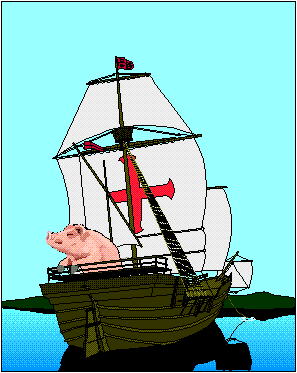 Before 1750 a very
substantial proportion of the world's population lived in rural areas and
engaged in subsistence farming activities. Food supply was never excessive,
famines occurred with some regularity, and surpluses were rare, even in the
most affluent regions. Such subsistence or near subsistence agriculture still
persists in many regions of the world.
Before 1750 a very
substantial proportion of the world's population lived in rural areas and
engaged in subsistence farming activities. Food supply was never excessive,
famines occurred with some regularity, and surpluses were rare, even in the
most affluent regions. Such subsistence or near subsistence agriculture still
persists in many regions of the world.
Shortages of food provided the major incentive for emigration to newly
discovered lands and reduced population pressure in some western European
countries. The colonists brought their own livestock with them, introducing new
species or strains from Europe into America, Australia, Africa and New Zealand.
This was not entirely a one-way exchange. Turkeys, corn (Zea maize),
potatoes and tobacco, species previously exploited only by agriculturists in
the Americas, were transported back to Europe and eventually spread around the
world. An extensive plantation and ranch based agriculture developed in the
colonies with a substantial proportion of colonial economy dependent on sending
grain and meat back to the mother countries.
Through modern technology, food self-sufficiency or even surpluses resulted in some regions that were traditional importers. Europe no longer needs or wants cereals, meats or dairy products from former colonies and now competes with them to dispose of its own excess production. This creates many problems including depressed producer incomes, excessive export subsidies and the need to develop new trading partners by many countries previously supplying food for EEC members.
The industrial revolution created a wave of urban migration through demand for more factory workers but also increased productivity of laborers remaining on farms. The first innovations of agricultural importance (1750-1880) produced some mechanized equipment for use on larger farms. Of even greater significance was mass manufacture of improved metal hand implements, making these available at reasonable cost so even peasant farmers could benefit. In addition, Pasteur's discoveries on preservation or processing were applied to various foods. Also, the development of clipper and later steam ships provided faster maritime shipment for cereals and other durable commodities from the colonies.
Although the practice of tilling the soil, growing of crops and rearing of
livestock was common throughout parts of Asia, Europe, Africa and even in the
Americas for millennia, it has a much shorter history in some other regions.
Settlers began moving into southern Ontario, clear cutting the forests,
establishing farms and displacing the indigenous peoples less than two hundred
years ago. The following note provides a brief insight into conditions around
Guelph at the beginning of the 20th century.
| "But seventy years or more have wrought very great changes, both on
the appearance of the county and its inhabitants, for it was in the year 1832
and the few following seasons that a great many immigrants arrived and settled
in Guelph and the surrounding townships." "In a few years some of the more thrifty of the settlers possessed a yolk of oxen and a sled, also a cow or two, and a few hogs, that fed mostly on beechnuts. These, with a quantity of fowls, kept the larder supplied with such varieties as beechnut fed pork, eggs, and very leaky milk and butter, maple sugar and molasses. Money was very scarce, and when we could sell eggs at three pence per dozen we thought it a good price. But these days and the pioneers have all passed from the changing scenes of the world, having served their day and generation. But to them and their successors, all honor and credit is due, for having changed a dense forest into a fruitful garden, and the haunts of the wolf and the bear into homes of peace and plenty, occupies by a refined, intelligent and educated people, both in city and country, who are also in the enjoyment of many of the improvements of an advanced civilization." David Kennedy Sr. (1903) Pioneer Days at Guelph and the County of Bruce. Reprinted by the Bruce County Historical Society. 1973. |
A more recent phase in agricultural evolution (1880-1950) produced further
farm mechanization, employed cold storage for long distance transport of meat
or processed dairy products and began the application of genetic selection for
livestock improvement. Simultaneously, the emerging science of agricultural
chemistry began contributing substantially to improvements in animal nutrition.
Since 1950, a better understanding of animal physiology and environmental
requirements, the selection of superior genotypes and the availability of
pharmaceuticals at reasonable costs resulted in the evolution of production
systems yielding very high biological efficiency. Research programs in the
areas of animal production and disease provided the background knowledge
necessary for development of efficient production practices that provide
consumers with animal products at reasonable prices. An almost limitless parade
of technical innovations diverted more and more resources for use by humans,
increasing their chances for survival and expansion, often at the expense of
other species. One consequence of this progression is that domesticated animals
became more and more dependent on people. Humans now exercise almost total
control over livestock activities and should assume full responsibility for
welfare.
| Some Major Highlights in the Evolution of Animal Production | |
| Long, long Ago | Small numbers of hunter-gatherers |
| circa 8,000 BCE | Earliest domestication of animals and cultivation
of plants. Beginnings of mixed farming. |
| circa 2,000 to 2,000 BCE | River civilizations (Sumar on
Tigris-Euphrates; Egyptian on Nile; Indian on Indus; Chinese on Yellow Rivers.
Mixed farming with small ruminants, pigs and poultry for meat and large ruminants mainly for work. |
| circa 1,000 BCE | Central and South American Indians had mixed farming with turkeys, cameloids, guinea pigs, corn, potatoes and tobacco. |
| 1st century | Romans spread innovations such as the iron share plow, different breeds of livestock and the fallow system throughout their empire. |
| 5th - 15th centuries | Dark Ages and Medieval Period |
| 16th century | Colonization begins and European livestock breeds transported to "New World." |
| 17th century | Formation of scientific societies and breed
associations. Europe imports considerable food from colonies. |
| 18th century | Industrial revolution promotes agricultural research, production and storage of forages, establishment of herd books and veterinary collages. |
| 19th century | Louis Pasteur: agricultural microbiology, chemistry and animal nutrition established as disciplines in agricultural colleges. |
| Early 20th century | Discipline approach to research and practical
application of results. Agricultural mechanization, refrigeration, Mendal rediscovered. |
| Mid 20th century | Antibiotics, AI, sire evaluation, more mechanization, move to monoculture, total confinements, European 'exotic breeds' to N America. |
| Late 20th century | Biotechnology rediscovered, recombinant DNA products, genetic engineering, interest in sustainable production. |
| 21st century | More emphasis on recycling (less on
specialization?). Food surpluses in some regions should lead to reduces government subsidies for surplus generating production. More society concerns about animal welfare, environmental quality and sustainability. Higher energy costs + questions about consumer preferences=uncertainty! |